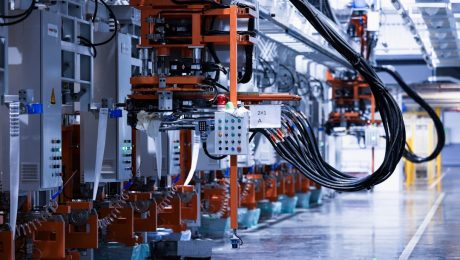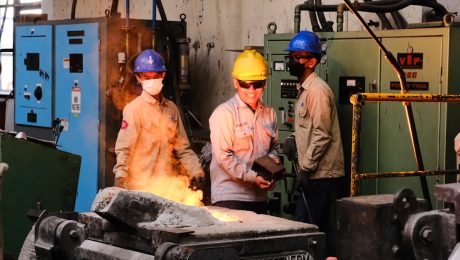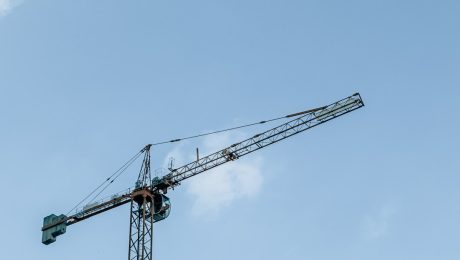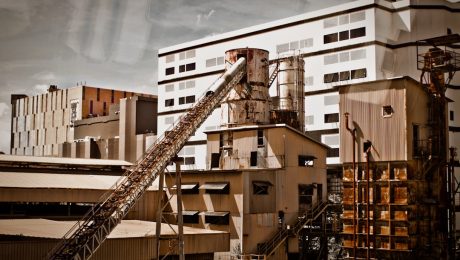In today’s fast-paced global market, efficient steel procurement and management are crucial for success. GlobalSteel’s suite of web tools offers a powerful solution, enabling businesses to streamline their operations and gain a competitive edge. This comprehensive guide will explore the key features and functionalities of these tools, demonstrating how they can revolutionize your steel management processes.
1. Streamlining Steel Procurement with GlobalSteel’s Online Marketplace
The GlobalSteel online marketplace is a game-changer for steel buyers. It provides a centralized platform to access a wide range of steel products from multiple suppliers, eliminating the need for time-consuming manual searches and negotiations. Key features include:
- Extensive Product Catalog: Browse a vast inventory of steel grades, sizes, and finishes, ensuring you find the precise materials you need.
- Real-time Pricing and Availability: Access up-to-the-minute pricing information and check inventory levels, facilitating informed purchasing decisions.
- Supplier Comparison: Compare offers from multiple suppliers side-by-side, allowing you to identify the best deals and optimize your costs.
- Secure Online Ordering: Place orders quickly and securely, with integrated tracking to monitor the progress of your shipments.
- Automated Order Management: Simplify order management with automated notifications, reminders, and reporting features.
2. Optimizing Inventory Management with GlobalSteel’s Inventory Tracking System
Effective inventory management is essential for preventing stockouts and minimizing storage costs. GlobalSteel’s inventory tracking system provides real-time visibility into your steel inventory, allowing you to make informed decisions about purchasing, storage, and allocation. This system offers:
- Real-time Inventory Updates: Track your inventory levels across multiple locations, ensuring accuracy and minimizing discrepancies.
- Automated Stock Alerts: Receive notifications when stock levels reach critical thresholds, preventing potential shortages and production delays.
- Detailed Reporting and Analytics: Generate customized reports to analyze inventory trends, identify areas for improvement, and optimize your stock management strategy.
- Integration with ERP Systems: Seamlessly integrate the inventory tracking system with your existing Enterprise Resource Planning (ERP) software for a holistic view of your operations.
- Predictive Analytics: Leverage advanced analytics to forecast future demand and optimize inventory levels based on historical data and market trends.
3. Enhancing Collaboration with GlobalSteel’s Communication Tools
Effective communication is vital for successful steel procurement and management. GlobalSteel’s integrated communication tools facilitate seamless collaboration between buyers, suppliers, and internal teams. These tools include:
- Secure Messaging System: Exchange messages securely with suppliers and internal stakeholders, ensuring confidentiality and efficient communication.
- Document Sharing: Share documents, such as specifications, drawings, and invoices, securely within the platform.
- Real-time Order Tracking Updates: Keep all stakeholders informed about the status of orders through real-time updates and notifications.
- Centralized Communication Hub: Consolidate all communication related to steel procurement and management in a single, easily accessible location.
- Customizable Notifications: Set up customized notifications for critical events, ensuring timely responses and proactive problem-solving.
4. Leveraging GlobalSteel’s Reporting and Analytics Dashboard for Data-Driven Decisions
Data-driven decision-making is critical for optimizing steel management processes. GlobalSteel’s reporting and analytics dashboard provides a comprehensive overview of your steel procurement and inventory data, allowing you to identify trends, optimize costs, and improve overall efficiency. Key features include:
- Customizable Reports: Generate customized reports on various aspects of your steel management, such as spending, inventory levels, and supplier performance.
- Interactive Dashboards: Visualize your data through interactive dashboards, providing a clear and concise overview of key performance indicators (KPIs).
- Trend Analysis: Identify trends in your steel consumption, pricing, and supplier performance to make informed decisions about future procurement strategies.
- Cost Optimization Insights: Analyze your spending patterns to identify areas for cost reduction and optimize your procurement processes.
- Performance Monitoring: Track the performance of your suppliers and identify potential issues proactively.
5. Ensuring Security and Compliance with GlobalSteel’s Secure Platform
Data security and compliance are paramount in today’s business environment. GlobalSteel’s platform utilizes robust security measures to protect your sensitive data and ensure compliance with industry regulations. This includes:
- Secure Data Encryption: All data transmitted and stored on the platform is encrypted to protect against unauthorized access.
- Access Control: Granular access control allows you to manage user permissions and ensure only authorized personnel can access sensitive information.
- Regular Security Audits: GlobalSteel conducts regular security audits to identify and address potential vulnerabilities.
- Compliance with Industry Standards: The platform is designed to comply with relevant industry standards and regulations.
- Data Backup and Recovery: Robust data backup and recovery mechanisms ensure business continuity in case of unforeseen events.
By leveraging the comprehensive suite of web tools offered by GlobalSteel, businesses can significantly improve their steel procurement and management processes, leading to increased efficiency, cost savings, and a stronger competitive position. Embrace the power of data-driven decision-making and experience the transformative impact of these innovative tools.
Tags: GlobalSteel, Steel Procurement, Steel Management, Inventory Management, Supply Chain Management
body { font-family: sans-serif; line-height: 1.6; }
h1, h2, h3 { color: #333; }
The steel industry, a cornerstone of global infrastructure and manufacturing, faces a monumental challenge: decarbonizing its operations to achieve net-zero emissions. This ambitious goal requires a fundamental shift in production methods, embracing innovation and collaboration across the entire value chain. This post delves into the complexities of achieving net-zero targets in steel production, exploring the hurdles, potential solutions, and the transformative impact on the industry’s future.
The Carbon Footprint of Steelmaking: Understanding the Challenge
Steel production is intrinsically energy-intensive and currently relies heavily on fossil fuels, primarily coal, for its energy needs. The blast furnace-basic oxygen furnace (BF-BOF) route, the dominant steelmaking process globally, is a significant contributor to greenhouse gas emissions. The process involves reducing iron ore with coke (derived from coal), releasing substantial amounts of carbon dioxide (CO2) into the atmosphere. Further emissions arise from the use of natural gas and electricity in various stages of the process, from raw material extraction to downstream processing. Quantifying this carbon footprint is crucial for setting realistic net-zero targets and developing effective decarbonization strategies. Life cycle assessments (LCAs) are increasingly utilized to comprehensively analyze the environmental impact of steel production, from ore mining to the end-of-life of steel products.
Emerging Technologies for Decarbonizing Steel Production
The pursuit of net-zero steel hinges on the development and deployment of innovative technologies. Several promising avenues are currently under investigation:
- Hydrogen-based steelmaking: Replacing coke with hydrogen as a reducing agent in the steelmaking process significantly reduces CO2 emissions. However, producing green hydrogen (via electrolysis powered by renewable energy) is crucial to avoid shifting emissions elsewhere. Research and development efforts are focused on optimizing hydrogen-based direct reduction processes and integrating them with electric arc furnaces (EAFs).
- Carbon Capture, Utilization, and Storage (CCUS): CCUS technologies capture CO2 emissions from steel plants and either utilize them in other industrial processes or store them underground. While effective in mitigating emissions, CCUS is currently expensive and faces challenges related to scalability and long-term storage security.
- Electric Arc Furnaces (EAFs): EAFs utilize electricity to melt scrap steel, significantly reducing CO2 emissions compared to BF-BOF routes. Increasing the proportion of scrap steel used in steelmaking is a crucial strategy for decarbonization. However, the availability of sufficient high-quality scrap steel is a limiting factor.
- Biomass-based fuels: Utilizing biomass as a sustainable alternative to coal in the blast furnace process can reduce CO2 emissions, but challenges remain in ensuring the sustainable sourcing of biomass and managing potential air pollution.
Policy and Regulatory Frameworks: Driving the Transition
Government policies and regulations play a critical role in accelerating the transition to net-zero steel. Carbon pricing mechanisms, such as carbon taxes or emissions trading schemes, can incentivize steel producers to adopt cleaner technologies. Furthermore, supportive policies for research and development, investment in renewable energy infrastructure, and the development of robust carbon accounting frameworks are essential. International collaboration is also crucial to establish consistent standards and avoid carbon leakage, ensuring a level playing field for steel producers globally. Stricter emission regulations and targets for the steel industry are driving investment and innovation in cleaner technologies.
The Role of Collaboration and Innovation in Achieving Net-Zero
Achieving net-zero emissions in steel production requires a collaborative effort involving steel producers, technology developers, researchers, policymakers, and consumers. Open innovation and the sharing of best practices are crucial for accelerating technological advancements and reducing the cost of decarbonization technologies. Public-private partnerships can foster the development and deployment of innovative solutions. Furthermore, increased consumer awareness and demand for sustainably produced steel can drive the market adoption of greener technologies. This collaborative approach is essential to overcome the technological, economic, and logistical hurdles involved in the transition.
The Future of Sustainable Steelmaking: A Vision for Net-Zero
The journey towards net-zero steel is ambitious but achievable. By combining technological innovation, supportive policies, and collaborative efforts, the steel industry can transform itself into a sustainable and environmentally responsible sector. The future of steelmaking will likely involve a mix of technologies, tailored to the specific circumstances of individual steel plants and regions. A diversified approach, encompassing hydrogen-based steelmaking, CCUS, increased EAF utilization, and the circular economy principles of maximizing scrap steel usage, will be crucial. The transition will require significant investments, but the long-term benefits – environmental sustainability, enhanced energy security, and economic opportunities – make it a worthwhile endeavor. The future of steel is green, and the path to achieving net-zero is paved with innovation and collective action.
Tags: Net-zero steel, sustainable steelmaking, green steel, decarbonization, steel industry emissions
body { font-family: sans-serif; line-height: 1.6; }
h1, h2, h3 { color: #333; }
h1 { font-size: 2.5em; }
h2 { font-size: 2em; }
h3 { font-size: 1.5em; }
Navigating the complex world of manufacturing standards can be daunting. European Norms (EN) standards, in particular, represent a crucial benchmark for quality, safety, and reliability. This comprehensive guide will delve into the intricacies of manufacturing to meet EN standards, offering a clear path to compliance and enhanced competitiveness.
Understanding the Importance of EN Standards in Manufacturing
EN standards are developed by European standardization organizations and adopted across many European countries. Compliance is often mandatory for certain products and industries, ensuring a consistent level of quality and safety for consumers. Meeting these standards isn’t merely about avoiding penalties; it’s about building trust, enhancing brand reputation, and accessing wider markets. Products conforming to EN standards demonstrate a commitment to excellence, attracting customers who value safety and reliability. Furthermore, complying with EN standards can streamline processes, reduce risks, and improve overall operational efficiency. This proactive approach to quality management minimizes costly recalls, legal battles, and reputational damage.
Identifying Relevant EN Standards for Your Products
The first step towards compliance is identifying the specific EN standards applicable to your products. This requires a thorough understanding of your manufacturing process and the characteristics of your final goods. The scope of EN standards is vast, covering everything from materials and manufacturing processes to finished product performance and safety. Resources like the European Committee for Standardization (CEN) website provide access to a comprehensive database of EN standards. Understanding the specific clauses and requirements within the relevant standards is crucial for effective implementation. Engaging with industry experts or consultants can provide valuable guidance in navigating this complex landscape and ensuring you select the appropriate standards for your specific needs.
Implementing EN Standards Throughout Your Manufacturing Process
Implementing EN standards isn’t a one-off task; it’s an ongoing process that requires integration throughout your entire manufacturing workflow. This involves establishing robust quality management systems (QMS), implementing rigorous testing procedures, and maintaining meticulous documentation. Key aspects include:
- Material Selection: Sourcing materials that meet the specified requirements outlined in relevant EN standards.
- Process Control: Implementing and monitoring processes to ensure consistency and adherence to standards at each stage of production.
- Quality Control: Regularly testing products at various stages to verify compliance with specified parameters.
- Documentation: Maintaining comprehensive records of materials, processes, test results, and any deviations from the standards.
- Employee Training: Ensuring your workforce is adequately trained on the relevant EN standards and procedures.
Achieving and Maintaining EN Certification
While compliance with EN standards is often mandatory, certification provides independent verification of your adherence. Certification involves a rigorous audit by a notified body, an organization accredited to assess conformity to EN standards. The audit process typically includes a review of your QMS, examination of your manufacturing processes, and testing of your products. Achieving certification demonstrates a commitment to quality and provides a competitive advantage in the marketplace. Maintaining certification requires ongoing monitoring and regular audits to ensure continued compliance. This continuous improvement cycle helps organizations enhance their processes and maintain the highest standards of quality and safety.
The Benefits of EN Standard Compliance: Beyond Compliance
The benefits of meeting EN standards extend far beyond simply avoiding penalties. Compliance translates to significant advantages:
- Enhanced Brand Reputation: Demonstrating a commitment to quality builds customer trust and loyalty.
- Increased Market Access: Compliance often opens doors to new markets, particularly within the European Union.
- Reduced Risks: Proactive compliance minimizes the risk of product recalls, legal action, and reputational damage.
- Improved Efficiency: Implementing standardized processes can streamline operations and improve overall efficiency.
- Competitive Advantage: Certification provides a clear differentiator in a competitive marketplace.
By prioritizing EN standard compliance, manufacturers can create a stronger, more resilient, and ultimately more successful business.
Meeting EN standards requires a dedicated approach, but the rewards are substantial. By understanding the importance of compliance, identifying relevant standards, implementing robust systems, and pursuing certification, manufacturers can position themselves for success in a global marketplace that increasingly values quality, safety, and reliability.
Tags: EN Standards, Manufacturing Standards, European Norms, Quality Management, Certification, Compliance
The production of high-quality steel is a complex process demanding meticulous attention to detail at every stage. From the selection of raw materials to the final product delivery, stringent quality control measures are essential to ensure the steel meets the required specifications and performance standards. This blog post delves into the critical methods employed throughout the process steel quality control chain, highlighting the importance of each step in delivering consistent, reliable, and high-performance steel.
1. Raw Material Inspection: The Foundation of Quality
The journey to superior steel begins with the careful selection and inspection of raw materials. This crucial first step involves rigorous testing of iron ore, scrap metal, and other components to ensure they meet the specified chemical composition and physical properties. Common tests include:
- Chemical Analysis: Spectroscopic methods (e.g., Optical Emission Spectrometry – OES) are used to determine the precise percentage of elements like carbon, manganese, silicon, phosphorus, and sulfur. These elements significantly influence the final steel’s properties.
- Physical Examination: This involves visual inspection for impurities, contaminants, and size consistency. For scrap metal, this includes checking for unwanted materials like plastics or non-ferrous metals.
- Moisture Content Analysis: Excessive moisture can negatively impact the smelting process. Therefore, accurate moisture content determination is vital.
Any deviations from the pre-defined specifications lead to rejection of the batch, ensuring only suitable raw materials enter the steelmaking process.
2. In-Process Monitoring: Maintaining Control During Steelmaking
Maintaining consistent quality throughout the steelmaking process is paramount. Continuous monitoring of various parameters is crucial to identify and rectify any potential deviations early on. Key aspects include:
- Temperature Control: Precise temperature regulation during melting, refining, and casting is crucial. Pyrometers and thermocouples are used for continuous monitoring and adjustment.
- Chemical Composition Monitoring: Regular chemical analysis during the refining process ensures the desired composition is achieved. This often involves automated sampling and analysis systems.
- Oxygen and Gas Control: Controlling the levels of oxygen and other gases in the molten steel is critical for achieving the desired properties. This involves using various techniques like argon purging.
- Inclusion Control: Non-metallic inclusions (e.g., oxides, sulfides) can negatively impact steel properties. Monitoring and controlling their levels is vital using techniques like vacuum degassing.
Real-time data acquisition and analysis systems enable immediate corrective actions, minimizing defects and maximizing yield.
3. Non-Destructive Testing (NDT): Assessing Steel Integrity Without Damage
Non-destructive testing (NDT) methods are employed to evaluate the integrity of the steel without causing any damage. These techniques play a vital role in identifying defects like cracks, porosity, and inclusions in the finished product. Common NDT methods used in steel quality control include:
- Ultrasonic Testing (UT): Uses high-frequency sound waves to detect internal flaws.
- Radiographic Testing (RT): Employs X-rays or gamma rays to create images revealing internal defects.
- Magnetic Particle Testing (MT): Detects surface and near-surface cracks in ferromagnetic materials.
- Liquid Penetrant Testing (PT): Identifies surface-breaking defects by using a dye that penetrates the crack and is then revealed by a developer.
- Eddy Current Testing (ECT): Uses electromagnetic induction to detect surface and subsurface flaws.
NDT ensures that the steel meets the required standards for structural integrity and safety.
4. Mechanical Testing: Evaluating Steel’s Performance Characteristics
Mechanical testing provides quantitative data on the steel’s strength, ductility, hardness, and other critical properties. These tests are crucial for verifying that the steel meets the required specifications for its intended application. Common mechanical tests include:
- Tensile Testing: Determines the ultimate tensile strength, yield strength, elongation, and reduction in area.
- Hardness Testing: Measures the resistance of the steel to indentation, using methods like Rockwell, Brinell, or Vickers hardness testing.
- Impact Testing: Evaluates the steel’s ability to withstand sudden impact loads, such as Charpy or Izod impact tests.
- Fatigue Testing: Assesses the steel’s resistance to failure under cyclic loading.
- Creep Testing: Determines the steel’s deformation under sustained stress at elevated temperatures.
The results of these tests are crucial for selecting the appropriate steel grade for specific applications.
5. Traceability and Documentation: Ensuring Accountability and Transparency
Maintaining meticulous records throughout the entire steel production process is essential for traceability and accountability. Detailed documentation of each step, including raw material specifications, process parameters, test results, and quality control checks, is crucial for ensuring product quality and identifying the root cause of any issues. This also helps in meeting industry standards and regulatory requirements. Modern techniques like digitalization and blockchain technology are increasingly used to enhance traceability and transparency in the steel industry.
Effective traceability allows for quick identification of potential problems and enables prompt corrective actions, enhancing overall efficiency and reducing waste.
In conclusion, the production of high-quality process steel relies heavily on a robust and comprehensive quality control system. By implementing these methods, steel manufacturers can ensure that their products consistently meet the required specifications, resulting in improved performance, enhanced safety, and increased customer satisfaction.
SEO Tags:
steel quality control, process steel quality, metallurgical testing, steel inspection methods, steel manufacturing quality
body {
font-family: sans-serif;
line-height: 1.6;
}
h1, h2, h3 {
color: #333;
}
img {
max-width: 100%;
height: auto;
}
The construction industry is undergoing a significant transformation, driven by the need for sustainable, efficient, and cost-effective building solutions. Hybrid construction techniques, which cleverly combine traditional building methods with modern, innovative approaches, are at the forefront of this revolution. This comprehensive guide delves into the various aspects of hybrid construction, exploring its benefits, challenges, and future potential.
Understanding the Essence of Hybrid Construction
Hybrid construction isn’t about simply using a mix of materials; it’s a strategic approach that leverages the strengths of different methods to optimize the entire building process. For example, a project might utilize prefabricated modular units (a modern technique) integrated into a traditional steel or timber frame structure. This blend can result in faster construction times, reduced on-site labor, improved precision, and enhanced sustainability. The key lies in carefully selecting materials and methods based on the specific project requirements, site conditions, and desired outcomes. This often involves a detailed analysis of lifecycle costs, considering factors like material sourcing, transportation, assembly, and long-term maintenance.
Popular Hybrid Construction Methods: A Detailed Look
Several hybrid approaches are gaining popularity. One common method involves combining steel frames with precast concrete elements. Steel provides strength and flexibility, while precast concrete offers durability and fire resistance. The precast components can be manufactured off-site, reducing construction time and minimizing on-site disruption. Another popular combination is timber frame structures integrated with cross-laminated timber (CLT) panels. CLT, a highly engineered wood product, offers excellent strength and stability, allowing for larger spans and faster construction. Furthermore, the use of mass timber in hybrid structures is becoming increasingly prevalent, offering a sustainable and aesthetically pleasing alternative to traditional materials. Other combinations include steel and masonry, concrete and bamboo, and even the integration of 3D-printed components into existing frameworks.
Benefits of Embracing Hybrid Construction Strategies
The advantages of hybrid construction are numerous. Firstly, it offers increased speed and efficiency. Off-site fabrication of components significantly reduces on-site construction time, leading to faster project completion. Secondly, it enhances precision and quality control. Prefabricated elements are manufactured in controlled factory environments, ensuring higher accuracy and reducing the risk of errors. Thirdly, it contributes to improved sustainability. Hybrid methods often incorporate sustainable materials like timber and recycled content, reducing the environmental impact of construction. Fourthly, it results in cost optimization. While initial investment might be higher in some cases, the overall cost can be reduced due to faster construction, reduced labor, and minimized waste. Finally, it offers greater design flexibility, allowing architects and engineers to explore innovative and creative building solutions.
Challenges and Considerations in Hybrid Projects
Despite the numerous benefits, hybrid construction also presents certain challenges. Coordination and integration of different materials and methods require meticulous planning and expertise. Effective communication between different teams involved in the project is crucial. Logistics and transportation of prefabricated components can be complex, particularly for larger projects or in areas with limited access. Furthermore, design and engineering need to address the compatibility of different materials and their structural interaction. The availability of skilled labor proficient in handling various construction techniques is also a crucial factor. Finally, regulatory compliance can be more intricate due to the use of multiple materials and methods, requiring careful adherence to building codes and standards.
The Future of Hybrid Construction: Trends and Innovations
The future of hybrid construction is bright, with ongoing advancements in materials science, digital technologies, and construction techniques. We can expect to see increased adoption of parametric design and Building Information Modeling (BIM) to optimize the design and construction process. The integration of advanced robotics and automation will further enhance efficiency and precision. The use of sustainable and recycled materials will become increasingly prevalent, promoting environmentally responsible building practices. Furthermore, we can anticipate the emergence of new hybrid methods, combining innovative materials and technologies to create even more sustainable, efficient, and cost-effective building solutions. Research into using bio-based materials, self-healing concrete, and smart building technologies will further shape the future landscape of hybrid construction.
Hybrid construction techniques represent a significant step towards a more sustainable, efficient, and innovative built environment. By overcoming the challenges and embracing the opportunities, the construction industry can leverage these methods to create buildings that are not only functional and aesthetically pleasing but also environmentally responsible and economically viable.
body {
font-family: sans-serif;
line-height: 1.6;
}
h1, h2, h3 {
color: #333;
}
h1 {
font-size: 2.5em;
}
h2 {
font-size: 2em;
}
h3 {
font-size: 1.5em;
}
The construction industry is undergoing a significant transformation, driven by the need for sustainable practices, faster construction times, and cost-effectiveness. Hybrid construction, a revolutionary approach that blends traditional building methods with modern techniques, is at the forefront of this change. This innovative approach offers a powerful solution to many of the challenges facing the industry today. Let’s delve into the fascinating world of hybrid construction and explore its various facets.
Understanding the Core Principles of Hybrid Construction
Hybrid construction, at its essence, involves combining different materials and construction methods to create a structure. This might involve integrating traditional materials like timber or brick with modern materials such as steel, concrete, or cross-laminated timber (CLT). The goal is to leverage the strengths of each material and technique, maximizing efficiency, sustainability, and overall performance. For example, a building might utilize a steel frame for structural support, while the exterior walls are constructed from prefabricated timber panels. This allows for rapid construction, reduces on-site waste, and provides a unique aesthetic.
Popular Hybrid Construction Methods: A Closer Look
Several popular hybrid construction methods are gaining traction in the industry. One prominent example is the combination of steel frames with precast concrete elements. Steel provides the structural skeleton, while precast concrete panels form the walls and floors, offering speed, precision, and improved quality control. Another common approach involves using timber frames with infill walls made of alternative materials like straw bales or hempcrete. This approach enhances the building’s thermal performance and reduces its carbon footprint. Furthermore, the integration of modular construction with traditional site-built elements is becoming increasingly prevalent, streamlining the building process and minimizing disruption.
Advantages of Embracing Hybrid Construction Techniques
The benefits of hybrid construction are manifold. Firstly, it offers significant time savings compared to traditional methods. Prefabrication and modularity reduce on-site construction time, accelerating project completion. Secondly, hybrid techniques often lead to cost reductions. Optimized designs and reduced labor costs contribute to a more economical building process. Thirdly, sustainability is a key advantage. The use of recycled materials and the integration of energy-efficient designs contribute to environmentally friendly buildings. Fourthly, hybrid construction enhances design flexibility. The combination of materials allows for greater creative freedom, enabling architects and engineers to explore innovative designs and tailor buildings to specific requirements. Finally, improved quality control is a significant benefit. Prefabrication allows for precise manufacturing in controlled environments, minimizing errors and ensuring high-quality construction.
Challenges and Considerations in Hybrid Construction Projects
Despite the numerous advantages, hybrid construction projects also present certain challenges. One major hurdle is the need for specialized expertise and skilled labor proficient in handling diverse materials and techniques. Effective coordination between different contractors and suppliers is crucial for seamless project execution. Another challenge relates to the design phase, which requires careful consideration of material compatibility and structural integrity. Moreover, regulatory approvals and compliance with building codes can be more complex for hybrid structures, requiring detailed documentation and rigorous inspections. Finally, the initial investment in specialized equipment and technology can be higher compared to traditional methods, although this is often offset by long-term cost savings.
Future Trends and Innovations in Hybrid Construction
The future of hybrid construction is bright, with ongoing innovations pushing the boundaries of what’s possible. The increasing adoption of Building Information Modeling (BIM) and digital fabrication techniques will enhance design efficiency and precision. The development of new, sustainable materials, such as bio-based composites and recycled materials, will further improve the environmental performance of hybrid structures. Furthermore, advancements in automation and robotics will streamline the construction process, making it faster, safer, and more efficient. We can expect to see more widespread adoption of off-site manufacturing and modular construction, leading to the creation of highly sustainable and resilient buildings.
In conclusion, hybrid construction techniques represent a significant advancement in the building industry, offering a path towards more sustainable, efficient, and cost-effective construction practices. While challenges remain, the numerous advantages and ongoing innovations make it a compelling approach for shaping the future of building design and construction.
Tags: Hybrid Construction, Sustainable Construction, Modern Construction, Building Techniques, Green Building
Steel, an alloy primarily of iron and carbon, forms the backbone of countless industries. Its versatility stems from the broad range of properties achievable by manipulating its composition. This guide delves into the diverse world of steel varieties, exploring their characteristics and applications.
Understanding Carbon Steels: The Foundation of Steel Production
Carbon steels represent the simplest and most common type of steel. Their properties are primarily determined by the carbon content, ranging from less than 0.05% to about 2.1%. Low-carbon steels (mild steels), with carbon content below 0.3%, are known for their ductility, weldability, and ease of forming. They’re widely used in construction, automotive parts, and general manufacturing. Medium-carbon steels (0.3% to 0.6% carbon) offer improved strength and hardness, making them suitable for applications requiring greater durability, such as railway tracks and machinery components. High-carbon steels (0.6% to 2.1% carbon), possess exceptional hardness and wear resistance, finding applications in tools, springs, and cutting blades. The higher the carbon content, generally the stronger and harder the steel, but at the cost of reduced ductility and weldability.
The Versatility of Alloy Steels: Enhancing Properties Through Additions
Alloy steels are enhanced by the addition of other alloying elements besides carbon, such as manganese, chromium, nickel, molybdenum, and vanadium. These additions significantly alter the steel’s properties, leading to a wide array of specialized applications. For instance, manganese increases strength and hardness, while chromium improves corrosion resistance. Nickel enhances toughness and ductility, and molybdenum boosts high-temperature strength. The specific combination of alloying elements determines the final properties of the alloy steel, allowing for tailored solutions for diverse engineering challenges. Common examples include high-strength low-alloy (HSLA) steels used in construction and automotive industries for their lightweight yet strong characteristics, and maraging steels renowned for their exceptional toughness and strength at high temperatures.
Stainless Steels: The Champions of Corrosion Resistance
Stainless steels are a subset of alloy steels characterized by their high chromium content (generally at least 10.5%). This chromium creates a passive chromium oxide layer on the steel’s surface, providing excellent resistance to corrosion and oxidation. Different grades of stainless steel offer varying degrees of corrosion resistance, strength, and workability. Austenitic stainless steels, like 304 and 316, are non-magnetic, highly ductile, and possess excellent corrosion resistance. They are widely used in food processing, chemical plants, and medical equipment. Ferritic stainless steels, such as 430, are magnetic and offer good corrosion resistance but are less ductile than austenitic grades. Martensitic stainless steels, like 410, are hardenable and possess high strength, often used in cutlery and surgical instruments. The choice of stainless steel grade depends heavily on the specific application and its environmental conditions.
Tool Steels: Precision and Durability in One Package
Tool steels are specifically designed for applications requiring exceptional hardness, wear resistance, and dimensional stability at high temperatures. They typically contain high levels of carbon and other alloying elements like tungsten, molybdenum, vanadium, and chromium. These elements contribute to the steel’s ability to retain its hardness even after repeated use and high temperatures. Different tool steels are optimized for specific machining operations such as cutting, drilling, and forming. High-speed steels (HSS), for example, are known for their ability to maintain hardness at high cutting speeds, while cold work tool steels are used for applications where high strength and wear resistance are crucial at room temperature. The selection of a tool steel heavily depends on the specific application’s demands.
Specialty Steels: Tailored Solutions for Unique Applications
Beyond the major categories, numerous specialty steels cater to niche applications requiring unique properties. These include steels with enhanced magnetic properties used in electrical motors and generators, cryogenic steels designed for extremely low temperatures, and steels with exceptional resistance to specific chemicals or environments. Examples include maraging steels (mentioned previously, but worth reiterating here due to their unique properties), which combine high strength with excellent toughness, and precipitation-hardening stainless steels, which achieve high strength through heat treatment rather than carbon content. The development of these specialty steels continues to push the boundaries of material science and engineering.
The selection of the appropriate steel for a given application requires careful consideration of its intended use, the environmental conditions, and the required mechanical properties. Understanding the vast array of steel varieties empowers engineers and designers to choose the optimal material for maximum performance and durability.
SEO-Friendly Tags:
- Steel Types
- Steel Grades
- Carbon Steel Properties
- Stainless Steel Applications
- Alloy Steel Selection
Entering international markets is a significant step for any business, promising growth and expanded reach. However, navigating the complex landscape of international product certifications is crucial for success. Failure to comply with local regulations can lead to significant penalties, product recalls, and damage to your brand reputation. This comprehensive guide will help you understand the importance and intricacies of obtaining the necessary certifications for your products.
Understanding the Importance of International Product Certifications
International product certifications are not merely bureaucratic hurdles; they are essential for ensuring product safety, quality, and compliance with legal requirements in different countries. These certifications demonstrate to consumers and regulatory bodies that your product meets specific standards, building trust and credibility. Without the appropriate certifications, your products may be seized at customs, banned from sale, or face legal action. The benefits extend beyond compliance, boosting your brand’s reputation, improving consumer confidence, and ultimately increasing sales opportunities in global markets.
Key International Certification Standards and Their Scope
The world is a patchwork of different certification standards, each with its specific requirements. Some of the most prominent include:
- CE Marking (European Union): This mandatory marking indicates conformity with health, safety, and environmental protection legislation within the European Economic Area. It’s not a single certification but rather a declaration of conformity based on various directives, depending on the product type. Failure to display the CE mark can result in significant fines and market exclusion.
- FCC Certification (United States): The Federal Communications Commission regulates radio frequency emissions and requires certification for electronic devices to ensure they don’t cause harmful interference. This is crucial for exporting electronic products to the US market.
- ISO Certifications (International Organization for Standardization): These are voluntary standards covering various aspects of quality management, environmental management, and other business processes. While not always legally mandated, ISO certifications (like ISO 9001 for quality management or ISO 14001 for environmental management) significantly enhance credibility and demonstrate a commitment to best practices, making your products more attractive to international buyers.
- GS Mark (Germany): This certification, issued by accredited testing and certification bodies, signifies that a product meets German safety requirements and is often recognized across Europe. It is a strong indicator of product quality and safety.
- CCC Certification (China): The China Compulsory Certification (CCC) is mandatory for a wide range of products imported or sold in China. It covers safety, electromagnetic compatibility, and other aspects, ensuring compliance with Chinese regulations.
This is not an exhaustive list, and the specific certifications required will vary significantly depending on the product, its intended market, and the relevant regulations.
Navigating the Certification Process: Steps to Success
The certification process can be complex and time-consuming. Here’s a general outline of the steps involved:
- Identify Relevant Certifications: Research the specific certifications required for your product in your target markets. Government websites and industry associations are valuable resources.
- Choose a Certification Body: Select an accredited testing and certification body recognized by the relevant authorities. Different bodies have varying fees and timelines.
- Product Testing: Your product will undergo rigorous testing to ensure it meets the required standards. This may involve laboratory testing, inspections, and audits.
- Documentation Review: You’ll need to provide comprehensive documentation, including technical specifications, design drawings, and test reports.
- Certification Issuance: Upon successful completion of testing and documentation review, the certification body will issue the relevant certification.
- Ongoing Compliance: Maintaining compliance is crucial. Regular audits and updates may be required to ensure your product continues to meet the specified standards.
Cost and Time Considerations for International Certifications
The cost and time required for obtaining international product certifications can vary greatly depending on several factors, including the complexity of the product, the number of certifications needed, and the chosen certification body. Testing and certification fees can range from a few hundred dollars to tens of thousands of dollars, and the entire process can take several months or even longer. It’s essential to factor these costs and timelines into your product development and launch plans. Careful planning and proactive engagement with certification bodies can help minimize delays and expenses.
Strategies for Efficient International Certification Management
Managing multiple international certifications can be challenging. Effective strategies include:
- Centralized Management System: Implement a system to track all certifications, deadlines, and related documentation.
- Collaboration with Experts: Engage experienced consultants or certification specialists to navigate the complexities of international regulations.
- Proactive Planning: Begin the certification process early in the product development cycle to avoid delays.
- Regular Audits and Reviews: Conduct regular audits to ensure ongoing compliance and identify potential issues early on.
- Leverage Technology: Utilize software and online tools to manage certifications, track deadlines, and streamline communication with certification bodies.
By implementing these strategies, businesses can significantly improve the efficiency and effectiveness of their international certification management.
Successfully navigating the world of international product certifications is key to unlocking global market opportunities. By understanding the importance of these certifications, familiarizing yourself with the relevant standards, and employing effective management strategies, businesses can significantly enhance their competitiveness in the global marketplace and avoid costly mistakes.
body {
font-family: sans-serif;
line-height: 1.6;
}
h1, h2, h3 {
color: #333;
}
Fire-resistant steel plays a critical role in safeguarding lives and property in countless applications, from skyscrapers and bridges to industrial facilities and vehicles. Its ability to withstand extreme temperatures and maintain structural integrity during a fire is paramount to ensuring safety and minimizing damage. This comprehensive guide delves into the fascinating world of fire-resistant steel, exploring its properties, applications, manufacturing processes, testing standards, and future innovations.
Understanding the Properties of Fire-Resistant Steel
Fire-resistant steel isn’t simply a single material; it’s a broad category encompassing various alloys designed to exhibit exceptional fire resistance. These steels achieve their fire-resistant properties through a combination of factors. Crucially, they possess a high melting point, preventing rapid collapse under intense heat. Their composition often includes elements like chromium, nickel, and molybdenum, which enhance their high-temperature strength and oxidation resistance. The microstructure of the steel also plays a crucial role, influencing its ability to withstand thermal shock and maintain its structural integrity. Furthermore, the thickness of the steel section contributes significantly to its fire resistance; thicker sections retain their strength for longer periods at elevated temperatures.
Manufacturing Processes and Alloying Techniques
The manufacturing process for fire-resistant steel involves precise control over composition, melting, casting, and heat treatment. High-quality raw materials are essential to ensure consistent performance. The precise alloying of elements like chromium, nickel, and molybdenum is crucial for achieving the desired high-temperature strength and oxidation resistance. Different manufacturing techniques, including electric arc furnaces and vacuum induction melting, are employed depending on the specific alloy and required purity. Following melting, the steel undergoes rigorous processes like rolling and forging to achieve the desired shape and dimensions. Heat treatment is then used to refine the microstructure and optimize the mechanical properties of the finished product. Strict quality control measures are implemented throughout the process to guarantee the final product meets stringent performance standards.
Key Applications of Fire-Resistant Steel in Construction and Industry
Fire-resistant steel finds extensive applications across various sectors. In construction, it forms the backbone of high-rise buildings, providing structural integrity in case of fire. It’s used in structural framing, columns, beams, and cladding. Bridges and tunnels also benefit from its superior fire resistance, ensuring continued safe passage even during emergencies. The industrial sector relies heavily on fire-resistant steel in manufacturing plants, refineries, and power generation facilities, protecting critical equipment and infrastructure. Furthermore, it’s incorporated into fire doors, fire-rated walls, and other passive fire protection systems. Transportation, including rail and automotive industries, utilizes fire-resistant steel to enhance the safety of vehicles and rolling stock.
Testing and Standards for Fire-Resistant Steel
Rigorous testing is crucial to verify the fire-resistant properties of steel. Standard test methods, such as those defined by ASTM (American Society for Testing and Materials) and ISO (International Organization for Standardization), are widely used. These tests assess the steel’s performance under controlled fire conditions, measuring parameters like temperature rise, load-bearing capacity, and deflection. Fire resistance ratings, typically expressed in terms of fire-resistance periods (e.g., 30 minutes, 60 minutes, 120 minutes), are assigned based on the test results. These ratings provide crucial information for engineers and designers to select the appropriate steel grade for specific applications. Compliance with relevant building codes and regulations is essential for ensuring the safety and integrity of structures incorporating fire-resistant steel.
Future Advancements and Innovations in Fire-Resistant Steel
Research and development continue to push the boundaries of fire-resistant steel technology. Scientists and engineers are exploring innovative alloying techniques to enhance the high-temperature strength, oxidation resistance, and ductility of these materials. The development of advanced high-strength low-alloy (HSLA) steels with improved fire resistance is a significant area of focus. Furthermore, investigations into innovative manufacturing processes, such as additive manufacturing (3D printing), hold the potential to produce complex shapes and customized fire-resistant steel components with enhanced performance. The integration of smart sensors and materials within fire-resistant steel structures is also being explored to improve fire detection and monitoring capabilities.
In conclusion, fire-resistant steel is an indispensable material for ensuring safety and minimizing damage in fire situations. Its unique properties, diverse applications, and ongoing advancements underscore its critical role in protecting lives and infrastructure across various sectors. The future of fire-resistant steel looks bright, with continuous innovation promising even more robust and reliable performance in the years to come.
SEO Tags:
- Fire-resistant steel
- Fire protection steel
- High-temperature steel
- Fire-resistant materials
- Structural steel fire protection
The steel sector, a cornerstone of global infrastructure and manufacturing, presents both immense opportunities and significant challenges for new entrants. Successfully navigating this complex landscape requires a well-defined market entry strategy. This comprehensive guide explores various approaches, considering the unique factors influencing the steel industry.
1. Understanding the Steel Market Landscape: A Crucial First Step
Before formulating any strategy, thorough market research is paramount. This involves analyzing several key aspects:
- Market Size and Growth Potential: Identifying regions with high demand and growth potential is crucial. Consider factors like infrastructure development, industrialization, and government policies.
- Competitive Analysis: Analyzing existing players, their market share, strengths, weaknesses, and strategies is essential for identifying opportunities and competitive advantages.
- Regulatory Landscape: Understanding import/export regulations, environmental regulations, and trade policies is vital for compliance and operational efficiency.
- Raw Material Availability and Costs: Access to raw materials like iron ore and coal significantly impacts production costs and profitability. Analyzing supply chains and pricing trends is critical.
- Technological Advancements: The steel industry is constantly evolving. Staying abreast of technological advancements in production processes, quality control, and sustainability is crucial for competitiveness.
2. Choosing the Right Market Entry Mode: Organic Growth vs. Acquisitions
Companies entering the steel sector have two primary choices for market entry: organic growth or acquisitions.
- Organic Growth: This involves establishing a new steel production facility or expanding existing operations. This approach requires significant capital investment, time, and expertise in steel production and management. It offers greater control but carries higher risk and slower returns.
- Acquisitions: Acquiring an existing steel company offers a faster route to market entry. This approach allows immediate access to established infrastructure, customer base, and distribution networks. However, it requires significant financial resources and careful due diligence to avoid potential liabilities and integration challenges.
The optimal choice depends on the company’s resources, risk appetite, and strategic goals. A hybrid approach, combining organic growth with strategic acquisitions, might be the most effective strategy in certain situations.
3. Strategic Alliances and Joint Ventures: Leveraging Synergies
Strategic alliances and joint ventures can be powerful tools for market entry in the steel sector. These collaborations allow companies to share resources, expertise, and risk, mitigating some of the challenges associated with independent market entry.
- Technology Transfer: Joint ventures can facilitate the transfer of advanced technologies and production techniques, enhancing efficiency and competitiveness.
- Access to Resources: Alliances can provide access to crucial raw materials, distribution networks, and financial resources.
- Market Penetration: Partnering with a local company can provide valuable insights into the local market, customer preferences, and regulatory environment.
- Risk Mitigation: Sharing the financial and operational risks associated with market entry can significantly reduce the burden on individual companies.
Careful selection of partners based on compatibility, shared goals, and complementary strengths is crucial for the success of such collaborations.
4. Navigating the Challenges: Regulatory Hurdles and Sustainability Concerns
The steel sector is subject to stringent regulations and increasing pressure to adopt sustainable practices. These factors present significant challenges for new entrants.
- Environmental Regulations: Meeting stringent environmental standards related to emissions, waste management, and water consumption is crucial. Investing in environmentally friendly technologies and processes is essential.
- Trade Policies and Tariffs: Import and export regulations, as well as tariffs, can significantly impact the competitiveness of steel producers. Understanding and adapting to these policies is essential for success.
- Labor Relations: Maintaining positive relationships with labor unions and ensuring fair labor practices are crucial for operational stability and social responsibility.
- Infrastructure Development: Access to reliable infrastructure, including transportation networks and energy supply, is crucial for efficient operations.
Proactive planning and investment in compliance and sustainability are essential for navigating these challenges and building a strong reputation.
5. Building a Strong Brand and Distribution Network: Ensuring Market Success
Once established, building a strong brand and efficient distribution network is critical for market success. This involves:
- Branding and Marketing: Developing a strong brand identity that communicates quality, reliability, and sustainability is essential for attracting customers.
- Distribution Channels: Establishing effective distribution channels to reach customers efficiently is crucial. This may involve direct sales, distributors, or a combination of both.
- Customer Relationship Management: Building strong relationships with customers through excellent service and responsiveness is essential for long-term success.
- Supply Chain Management: Efficient supply chain management is crucial for ensuring timely delivery and minimizing costs.
A well-defined marketing strategy, coupled with a robust distribution network, is essential for capturing market share and achieving sustainable growth.
Entering the steel sector requires a carefully crafted strategy that considers all aspects of the market, from regulatory compliance to brand building. By conducting thorough research, selecting the appropriate entry mode, and proactively addressing challenges, companies can increase their chances of forging success in this dynamic and competitive industry.
SEO Tags: Steel market entry, steel industry strategy, market entry strategies, steel sector investment, steel industry analysis










